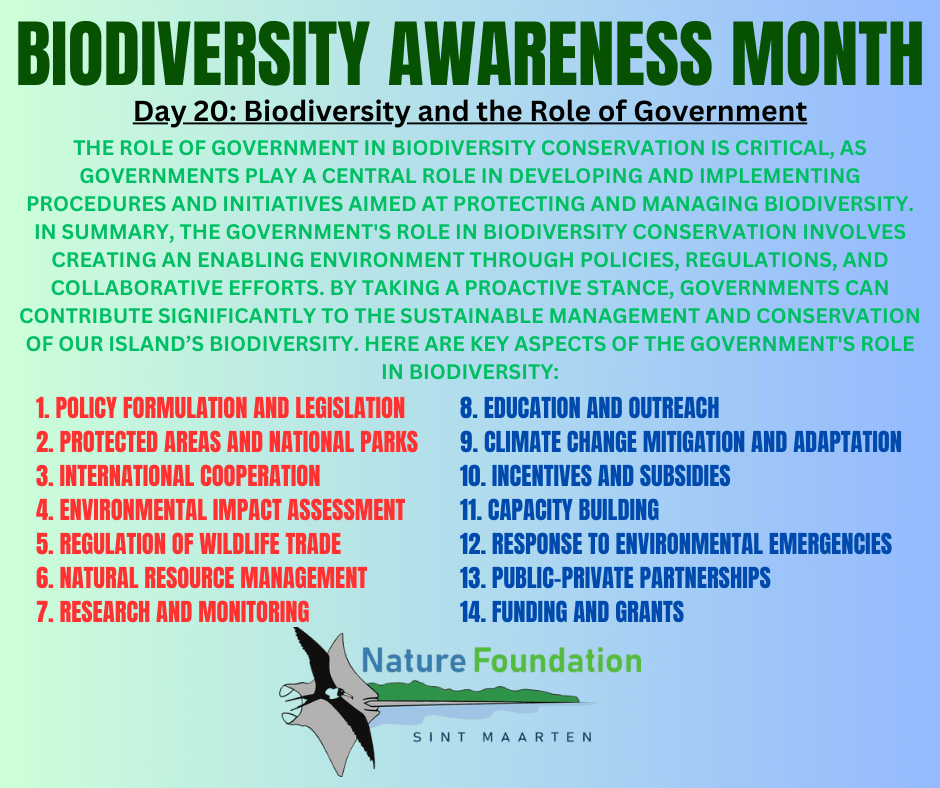Biodiversity month day 20: Biodiversity and the role of government
The role of government in biodiversity conservation is critical, as governments play a central role in developing and implementing policies, regulations, and initiatives aimed at protecting and managing biodiversity.
The St. Maarten Hospitality & Trade Association supports the March Biodiversity awareness month organized by the Nature Foundation in an effort to help protect St. Maartens nature and biodiversity. Todays topic: Biodiversity and the role of Government
Here are key aspects of the government’s role in biodiversity:
1. Policy Formulation and Legislation: Governments are responsible for developing comprehensive policies and legislation that address biodiversity conservation. These policies set the legal framework for protecting ecosystems, wildlife, and natural resources.
2. Protected Areas and National Parks: Governments establish and manage protected areas and national parks to preserve natural habitats and ensure the survival of diverse plant and animal species. These areas serve as refuges for wildlife and contribute to the overall conservation of biodiversity.
3. International Cooperation: Governments engage in international collaborations and agreements to address transboundary biodiversity issues. Participation in global initiatives and treaties, such as the Convention on Biological Diversity (CBD), demonstrates a commitment to global biodiversity conservation.
4. Environmental Impact Assessment (EIA): Governments mandate and oversee Environmental Impact Assessments to evaluate the potential environmental effects of development projects. EIAs help ensure that projects are conducted in a manner that minimizes harm to biodiversity.
5. Regulation of Wildlife Trade: Governments regulate and enforce laws related to the international and domestic trade of wildlife to prevent illegal trafficking, overexploitation, and the spread of diseases. These regulations contribute to the protection of biodiversity.
6. Natural Resource Management: Governments are responsible for managing natural resources, including forests, water, and fisheries, in a sustainable manner. Policies and practices related to resource extraction and land use directly impact biodiversity.
7. Research and Monitoring: Governments fund and conduct scientific research on biodiversity. Monitoring programs help track changes in ecosystems, assess the status of endangered species, and provide data for informed decision-making.
8. Education and Outreach: Governments play a role in educating the public about the importance of biodiversity and environmental conservation. Awareness campaigns, school programs, and community engagement initiatives contribute to public understanding and support.
9. Climate Change Mitigation and Adaptation: Governments address climate change, a significant threat to biodiversity, through policies and actions aimed at mitigation and adaptation. Strategies to reduce greenhouse gas emissions and enhance ecosystem resilience contribute to biodiversity conservation.
10. Incentives and Subsidies: Governments may implement incentive programs and subsidies to encourage sustainable practices. Financial support for environmentally friendly approaches, such as organic farming or habitat restoration, promotes biodiversity conservation.
11. Capacity Building: Governments invest in building the capacity of relevant agencies and organizations involved in biodiversity conservation. This includes training personnel, developing expertise, and ensuring effective implementation of conservation measures.
12. Response to Environmental Emergencies: Governments are responsible for responding to environmental emergencies, such as oil spills, natural disasters, or disease outbreaks, to minimize their impact on biodiversity. Timely and effective responses are crucial for ecosystem recovery.
13. Public-Private Partnerships: Governments can engage with the private sector through partnerships that promote sustainable practices. Collaborations with businesses and industries can lead to the development of biodiversity-friendly policies and initiatives.
14. Funding and Grants: Governments allocate funding and provide grants to support biodiversity conservation initiatives. Financial support may come from national budgets, international aid, or public-private partnerships.
In summary, the government’s role in biodiversity conservation involves creating an enabling environment through policies, regulations, and collaborative efforts. By taking a proactive stance, governments can contribute significantly to the sustainable management and conservation of Earth’s biodiversity.
Back to the Visit St Maarten Main page

